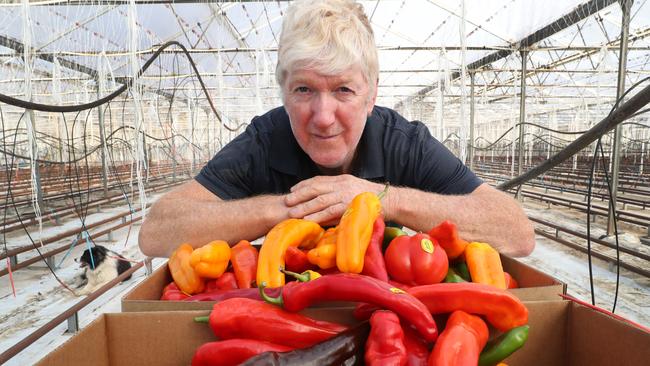Why a ‘perfect storm’ has increased your grocery bill at Victorian supermarkets
A “perfect storm” of challenges is causing fresh produce to jump to eye-watering prices. But Victorian farmers are not profiting.
Leader
Don't miss out on the headlines from Leader . Followed categories will be added to My News.
Farmers say they’ve been unfairly asked to bear the brunt of surging costs in an effort to ease rising costs of grocery staples.
Supply shortages of some fresh produce items have led shoppers to express outrage over the rising cost of items such as capsicums and iceberg lettuce – the latter reaching up to $12 in some supermarkets.
Based in Werribee South, Velisha Farms managing director Catherine Velisha says a “perfect storm” across the horticultural industry has led to the price shifts.
“Every winter growing slows in Victoria due to the cold conditions so the bulk of our fresh produce is coming from Queensland,” she said.
“It’s really a perfect storm, the floods in Queensland wiped out huge crops. Some producers were only able to salvage one 10th of their produce.”

According to Ms Velisha, farmers were unfairly being asked to bear the rising costs of food production, such as fuel, fertilisers and wages, to help keep the cost of living down for households.
“The reality is our businesses are facing the same pressures as every household,” she said.
“Why aren’t the same standards being applied to gas, petrol or electricity providers?”
RMIT associate professor of economics Bilgehan Karabay said the impact of natural disasters often led to rising prices for fresh produce, pointing to Cyclone Yasi in 2011 which caused banana prices to jump from $2 to $15 for a kilogram.
“There’s not much you can do to prevent this kind of price rise,” he said.
“These are essential goods and demand is fairly inelastic – you can’t just switch to a cheaper provider.”

He said global factors including the Russian invasion in Ukraine had led to supply chain problems and driven costs of essential goods higher.
Ms Velisha believes some relief is on the horizon for fresh produce, with large crops replanted in Queensland now flood-affected areas have dried, but cautioned other factors impacting prices weren’t easing.
“Input costs are going up and we’re probably going to need government assistance to keep shelf prices down long-term,” she said.
She recommends choosing seasonal produce to help ease a growing grocery bill, or substituting in cheaper ingredients if following a recipe.
“In any dish vegetables can easily be switched,” she said.
“If eggplants are expensive try substituting in zucchini, or for lettuce use shredded carrot instead.”

David Wallace from Wallace Vegetable Farm in Keilor grows capsicums hydroponically in warmer months.
He said high vegetable prices were simply a matter of supply and demand at the point of production — the farm — and would probably be short-lived.
“Most of your warmer climate produce all comes from Queensland this time of year, but it’s just the circumstances,” he said.
“To have two floods in certain growing areas within a month is very rare and extremely costly.
“In reality, no one would be making any money out of this — not the growers, because to get this enormous price means it’s very scarce.”
But the risk and costs of farming were so high, Mr Wallace said, that people should be more concerned with the long-term viability of agricultural work.
He said seed had to be ordered nearly a year in advance, fertiliser prices had more than doubled, fuel was more expensive, there were labour shortages to boot, and input costs were extremely high.
“It might be our last year, the next season,” Mr Wallace said.
“Before I make one dollar, this year I have to spend $120,000. Just to get started.
“Who else goes to work every week having to lay out that sort of money before they make a dollar?”
He warned that if costs compounded further, the country could lose its next generation of farmers.
“Where are Australian people gong to get their food from?” Mr Wallace said.
“If we don’t look after the people who are growing vegetables in this country now, there will be a big problem because there’ll be no one left to grow it.
“As a household you worry about two or three items, but everything we [farmers] purchase to make the crops grow has gone up at least 50 to 100 per cent. That’s not sustainable.
“And without money you can’t plant the next crop - that’s why a lot of growers will just say, ‘That’s it.’”




